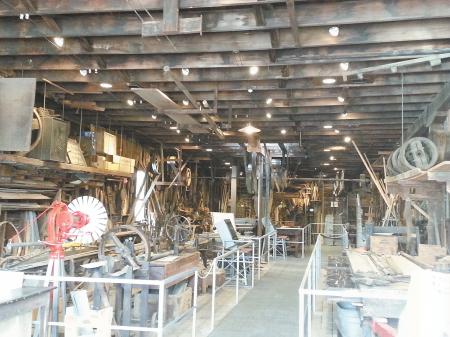
The
Kregel windmill factory closed in 1991 and reopened as a museum with one of
only 13 line shaft systems left in the U.S. Line shafts systems were common in
factories and shops in the 19th and early 20th century. A central shaft driven
by an engine, electrical motor or water wheel, powers various belt-driven
tools.
“The line shaft and all the belt-driven
equipment still operate,” says David Flatt, Kregel Windmill Factory Museum. “The
last windmill built by the company was the same design and produced the same
way as when the factory was built in 1902.”
Tools include a metal turning lathe built in
1865 and a power shear, punch and riveting machine built
in 1875. Most of the tools, like saws, drop hammer, joiner and grinders, were
manufactured in 1900 or 1910.
The
Kregel Windmill Company produced approximately 1,000 Eli brand windmills over
its 112-year history. However, it’s the only surviving factory of the 1,500
windmill companies that once operated in the U.S. Its revival as a museum is
unique.
“When
the 93-year-old owner died, the factory was closed,” explains Flatt. “The
Kimball and Ward foundations and others approached heirs to the estate
suggesting setting it up as a non-profit museum and offered to raise operating
funds.”
While
everything inside the building worked perfectly, the structure needed work. The
tin plate exterior was removed piece-by-piece, numbered and stored. Once
repairs were made, the tin was replaced.
The
interior is a time capsule of factory life 100 years ago or more. Not only
tools, but also ledger books on shelves, pencils and pens on the desk, even an
overcoat on a hook remain where last used. More than a million and a half
artifacts can be found in the building.
“It
even smells like an old factory,” says Flatt. “The only changes were to remove
excess pieces of pipe and towers so people could walk around. It is handicapped
accessible, and we installed computer kiosks with informational videos.”
An
Eli windmill with a 31-ft. tower and 10-ft. wheel is on display across the street
from the museum. The windmills came in 25, 31, 36 and 53-ft. heights. Many can
still be found in service.
“The
Eli is a direct stroke windmill with no gears to go wrong,” explains Flatt. “Most
were sold within a 50-mile radius of the factory, and about 100 are left.”
The
museum is open year-round Tuesday through Sunday. It hosts special events and
lectures, as well as tours for around 3,000 visitors each year.
